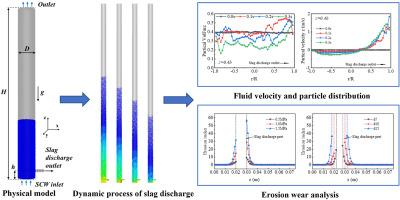超临界水流化床压差驱动排渣过程的数值模拟研究
IF 4.3
2区 材料科学
Q2 ENGINEERING, CHEMICAL
引用次数: 0
摘要
超临界水流化床排渣过程的模拟具有挑战性,因为高温高压环境下颗粒输运的复杂性。为了平衡计算效率和对详细颗粒级信息的需求,本研究提出了一种基于计算颗粒流体动力学(CPFD)的动态三维数值模型来研究SCW流化床反应器的排渣过程。本研究通过对排渣过程中流场、速度场和颗粒相体积分数分布的动态演化,揭示了颗粒分布不均匀与流场之间的关系。在排渣过程中,大颗粒料难以从反应器底部排出。通过增加放料时间,可以有效缓解反应器底部死区问题。颗粒速度越快,颗粒撞击频率越高,对排渣口附近壁面的磨损越严重。降低排渣压差有助于减少连接的磨损。在整个放渣过程中,固含率保持在90%以上,表明了该系统的高效和快速。这项工作旨在为排渣系统的设计和优化提供有价值的见解。本文章由计算机程序翻译,如有差异,请以英文原文为准。

Numerical simulation study of slag discharge process driven by pressure difference in a supercritical water fluidized bed
The simulation of the slag discharging process in supercritical water (SCW) fluidized beds is challenging due to the complexity of particle transport in a high-temperature and high-pressure environments. To balance computational efficiency with the need for detailed particle-level information, this study proposes a dynamic three-dimensional numerical model based on computational particle fluid dynamics (CPFD) to investigate the slag discharge process in a SCW fluidized bed reactor. This study presents the dynamic evolution of the flow field, velocity field, and particle phase volume fraction distribution during the slag discharge process, revealing the relationship between the uneven particle distribution and the flow field. Large particles are difficult to be discharged from the bottom of the reactor during the slag discharge process. By increasing the discharging time, the problem of dead zone at the bottom of the reactor can be alleviated effectively. Higher particle velocities and more frequent particle impacts cause more severe wear on the wall near the slag discharge outlet. Reducing the slag discharge differential pressure helps to reduce the wear of the connection. Throughout the entire slag discharge process, the solid holdup remains above 90 %, demonstrating the efficiency and rapidity of the slag discharge system. This work aims to provide valuable insights for the design and optimization of slag discharge systems.
求助全文
通过发布文献求助,成功后即可免费获取论文全文。
去求助
来源期刊

Particuology
工程技术-材料科学:综合
CiteScore
6.70
自引率
2.90%
发文量
1730
审稿时长
32 days
期刊介绍:
The word ‘particuology’ was coined to parallel the discipline for the science and technology of particles.
Particuology is an interdisciplinary journal that publishes frontier research articles and critical reviews on the discovery, formulation and engineering of particulate materials, processes and systems. It especially welcomes contributions utilising advanced theoretical, modelling and measurement methods to enable the discovery and creation of new particulate materials, and the manufacturing of functional particulate-based products, such as sensors.
Papers are handled by Thematic Editors who oversee contributions from specific subject fields. These fields are classified into: Particle Synthesis and Modification; Particle Characterization and Measurement; Granular Systems and Bulk Solids Technology; Fluidization and Particle-Fluid Systems; Aerosols; and Applications of Particle Technology.
Key topics concerning the creation and processing of particulates include:
-Modelling and simulation of particle formation, collective behaviour of particles and systems for particle production over a broad spectrum of length scales
-Mining of experimental data for particle synthesis and surface properties to facilitate the creation of new materials and processes
-Particle design and preparation including controlled response and sensing functionalities in formation, delivery systems and biological systems, etc.
-Experimental and computational methods for visualization and analysis of particulate system.
These topics are broadly relevant to the production of materials, pharmaceuticals and food, and to the conversion of energy resources to fuels and protection of the environment.
 求助内容:
求助内容: 应助结果提醒方式:
应助结果提醒方式:


